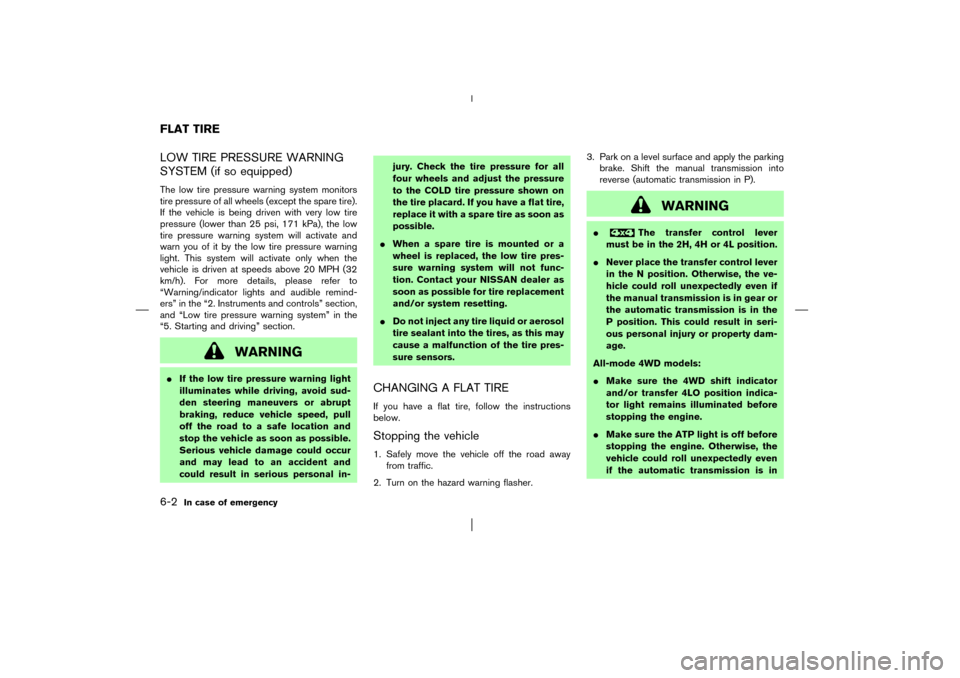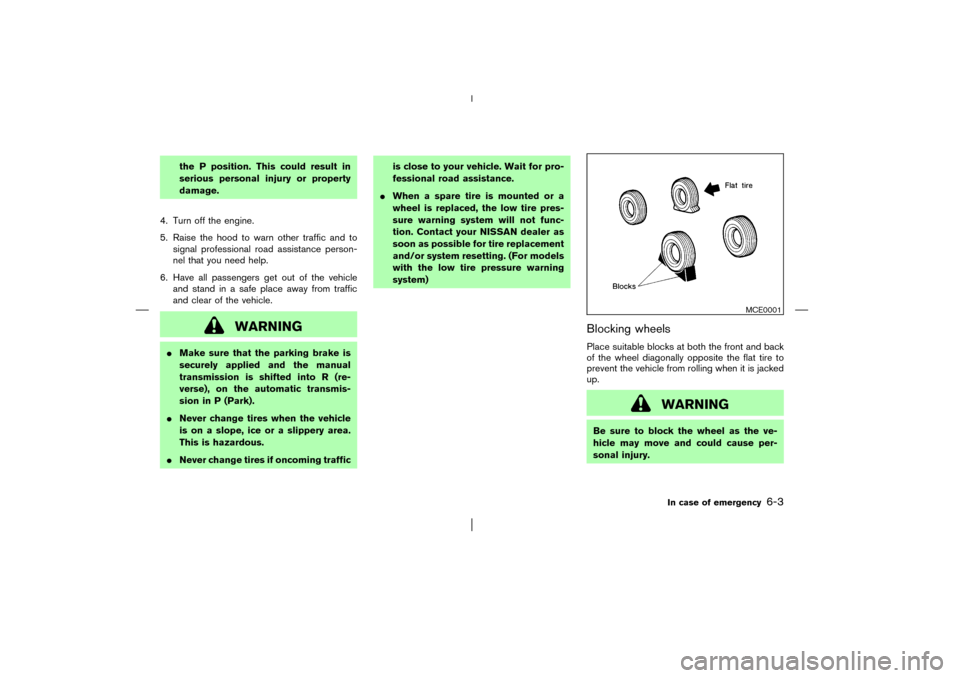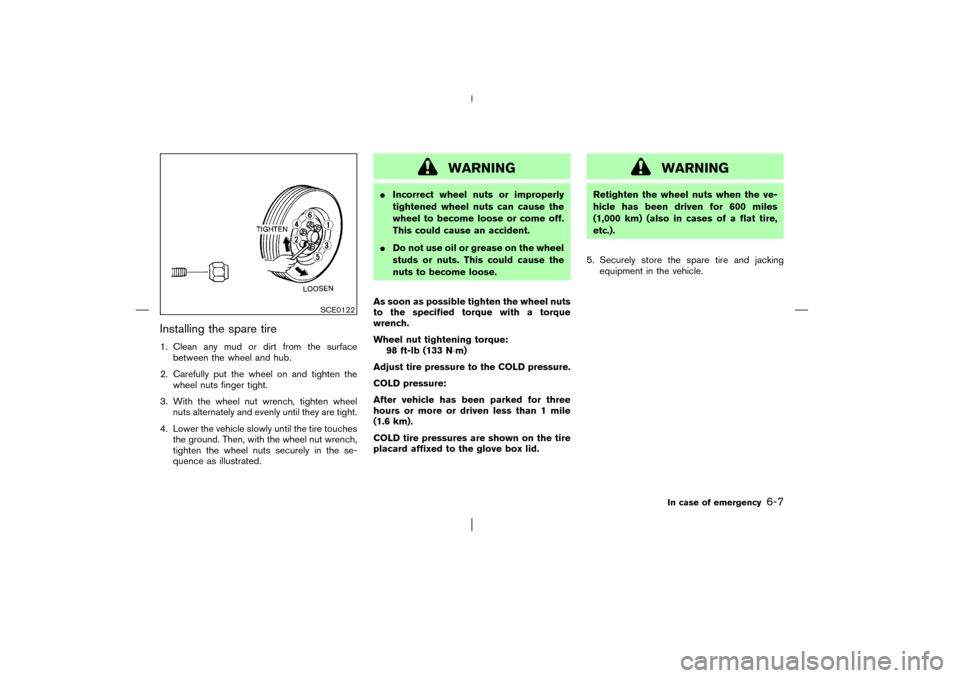Page 199 of 299

LOW TIRE PRESSURE WARNING
SYSTEM (if so equipped)The low tire pressure warning system monitors
tire pressure of all wheels (except the spare tire).
If the vehicle is being driven with very low tire
pressure (lower than 25 psi, 171 kPa), the low
tire pressure warning system will activate and
warn you of it by the low tire pressure warning
light. This system will activate only when the
vehicle is driven at speeds above 20 MPH (32
km/h). For more details, please refer to
“Warning/indicator lights and audible remind-
ers” in the “2. Instruments and controls” section,
and “Low tire pressure warning system” in the
“5. Starting and driving” section.
WARNING
�If the low tire pressure warning light
illuminates while driving, avoid sud-
den steering maneuvers or abrupt
braking, reduce vehicle speed, pull
off the road to a safe location and
stop the vehicle as soon as possible.
Serious vehicle damage could occur
and may lead to an accident and
could result in serious personal in-jury. Check the tire pressure for all
four wheels and adjust the pressure
to the COLD tire pressure shown on
the tire placard. If you have a flat tire,
replace it with a spare tire as soon as
possible.
�When a spare tire is mounted or a
wheel is replaced, the low tire pres-
sure warning system will not func-
tion. Contact your NISSAN dealer as
soon as possible for tire replacement
and/or system resetting.
�Do not inject any tire liquid or aerosol
tire sealant into the tires, as this may
cause a malfunction of the tire pres-
sure sensors.
CHANGING A FLAT TIREIf you have a flat tire, follow the instructions
below.Stopping the vehicle1. Safely move the vehicle off the road away
from traffic.
2. Turn on the hazard warning flasher.3. Park on a level surface and apply the parking
brake. Shift the manual transmission into
reverse (automatic transmission in P).
WARNING
�
The transfer control lever
must be in the 2H, 4H or 4L position.
�Never place the transfer control lever
in the Nposition. Otherwise, the ve-
hicle could roll unexpectedly even if
the manual transmission is in gear or
the automatic transmission is in the
P position. This could result in seri-
ous personal injury or property dam-
age.
All-mode 4WD models:
�Make sure the 4WD shift indicator
and/or transfer 4LO position indica-
tor light remains illuminated before
stopping the engine.
�Make sure the ATP light is off before
stopping the engine. Otherwise, the
vehicle could roll unexpectedly even
if the automatic transmission is in
FLAT TIRE6-2
In case of emergency
�
03.1.28/R50-D/V5
�
Page 200 of 299

the P position. This could result in
serious personal injury or property
damage.
4. Turn off the engine.
5. Raise the hood to warn other traffic and to
signal professional road assistance person-
nel that you need help.
6. Have all passengers get out of the vehicle
and stand in a safe place away from traffic
and clear of the vehicle.
WARNING
�Make sure that the parking brake is
securely applied and the manual
transmission is shifted into R (re-
verse), on the automatic transmis-
sion in P (Park).
�Never change tires when the vehicle
is on a slope, ice or a slippery area.
This is hazardous.
�Never change tires if oncoming trafficis close to your vehicle. Wait for pro-
fessional road assistance.
�When a spare tire is mounted or a
wheel is replaced, the low tire pres-
sure warning system will not func-
tion. Contact your NISSAN dealer as
soon as possible for tire replacement
and/or system resetting. (For models
with the low tire pressure warning
system)
Blocking wheelsPlace suitable blocks at both the front and back
of the wheel diagonally opposite the flat tire to
prevent the vehicle from rolling when it is jacked
up.
WARNING
Be sure to block the wheel as the ve-
hicle may move and could cause per-
sonal injury.
MCE0001
In case of emergency
6-3
�
03.1.28/R50-D/V5
�
Page 201 of 299
Getting the spare tire and toolsRemove jacking tools and spare tire from stor-
age area.
SCE0339C
SCE0120
SCE0116B
6-4
In case of emergency
�
03.1.28/R50-D/V5
�
Page 202 of 299
CAUTION
�Do not insert the jack rod straight as
it is designed to be inserted at an
angle as shown.
�Make sure the rod tip fits in the fitting
portion of the spare tire hanger and
turn the rod.
�Be sure to center the spare tire sus-
pending plate on the wheel and then
lift the spare tire.
Removing wheel cap
CAUTION
Do not use your hands to pry off wheel
caps. Doing so could result in personal
injury.
SCE0377
SCE0326SCE0327
SCE0139C
In case of emergency
6-5
�
03.1.28/R50-D/V5
�
Page 204 of 299

Installing the spare tire1. Clean any mud or dirt from the surface
between the wheel and hub.
2. Carefully put the wheel on and tighten the
wheel nuts finger tight.
3. With the wheel nut wrench, tighten wheel
nuts alternately and evenly until they are tight.
4. Lower the vehicle slowly until the tire touches
the ground. Then, with the wheel nut wrench,
tighten the wheel nuts securely in the se-
quence as illustrated.
WARNING
�Incorrect wheel nuts or improperly
tightened wheel nuts can cause the
wheel to become loose or come off.
This could cause an accident.
�Do not use oil or grease on the wheel
studs or nuts. This could cause the
nuts to become loose.
As soon as possible tighten the wheel nuts
to the specified torque with a torque
wrench.
Wheel nut tightening torque:
98 ft-lb (133 N⋅m)
Adjust tire pressure to the COLD pressure.
COLD pressure:
After vehicle has been parked for three
hours or more or driven less than 1 mile
(1.6 km).
COLD tire pressures are shown on the tire
placard affixed to the glove box lid.
WARNING
Retighten the wheel nuts when the ve-
hicle has been driven for 600 miles
(1,000 km) (also in cases of a flat tire,
etc.).
5. Securely store the spare tire and jacking
equipment in the vehicle.
SCE0122
In case of emergency
6-7
�
03.1.28/R50-D/V5
�
Page 205 of 299
Stowing the damaged tire and toolsSecurely store the tire and jacking equipment in
the vehicle as illustrated.
WARNING
�Always make sure that the spare tire
and jacking equipment are properly
secured after use. Such items can
become dangerous projectiles in an
accident or sudden stop.
�The small size spare tire is designedfor emergency use. See “Tires and
wheels” in the “8. Maintenance and
do-it-yourself” section.
Tightening torque of nuts:
48 to 66 ft-lb
(66 to 89 N⋅m)
Use a suitable padlock.
SCE0339C
SCE0244
6-8
In case of emergency
�
03.1.28/R50-D/V5
�
Page 223 of 299

Your new NISSAN has been designed to have
minimum maintenance requirements with longer
service intervals to save you both time and
money. However, some day-to-day and regular
maintenance is essential to maintain your NIS-
SAN’s good mechanical condition, as well as its
emission and engine performance.
It is the owner’s responsibility to make sure that
scheduled maintenance, as well as general
maintenance, is performed.
As the vehicle owner, you are the only one who
can ensure that your vehicle receives the proper
maintenance care. You are a vital link in the
maintenance chain.
Scheduled maintenance:
For your convenience, both required and op-
tional scheduled maintenance items are de-
scribed and listed in your “Service and Mainte-
nance Guide”. You must refer to that guide to
ensure that necessary maintenance is performed
on your NISSAN at regular intervals.
General maintenance:
General maintenance includes those items
which should be checked during normal day-to-
day operation of the vehicle. They are essential if
your vehicle is to continue to operate properly. It
is your responsibility to perform these proce-
dures regularly as prescribed.Performing general maintenance checks require
minimal mechanical skill and only a few general
automotive tools.
These checks or inspections can be done by
yourself, a qualified technician or, if you prefer,
your NISSAN dealer.
Where to go for service:
If maintenance service is required or your vehicle
appears to malfunction, have the systems
checked and tuned by NISSAN dealer.
NISSAN technicians are well-trained specialists
and are kept up to date with the latest service
information through technical bulletins, service
tips, and in-dealership training programs. They
are completely qualified to work on NISSAN
vehiclesbeforethey work on your vehicle,
rather than after they have worked on it.
You can be confident that your NISSAN dealer’s
service department performs the best job to
meet the maintenance requirements of your ve-
hicle — in a reliable and economic way.During the normal day-to-day operation of the
vehicle, general maintenance should be per-
formed regularly as prescribed in this section. If
you detect any unusual sounds, vibrations or
smell, be sure to check for the cause or have
your NISSAN dealer check it promptly. In addi-
tion, you should notify your NISSAN dealer if you
think that repairs are required.
When performing any checks or maintenance
work, closely observe the “Maintenance precau-
tions” later in this section.
EXPLANATION OF GENERAL
MAINTENANCE ITEMSAdditional information on the following
items with “*” is found later in this section.Outside the vehicleThe maintenance items listed here should be
performed from time to time, unless otherwise
specified.
Tires*:
Check the pressure with a gauge at least once a
month and always prior to long distance trips. If
necessary, adjust the pressure in all tires, includ-
ing the spare, to the pressure specified. Check
carefully for damage, cuts or excessive wear.
MAINTENANCE REQUIREMENTS GENERAL MAINTENANCE8-2
Maintenance and do-it-yourself
�
03.1.28/R50-D/V5
�
Page 255 of 299
If you have a flat tire, see “Flat tire” in the
“6. In case of emergency” section.TIRE PRESSURE
Maximum inflation pressureDo not exceed the maximum inflation pressures
shown on the side wall of the tire.Tire inflation pressureCheck the tire pressure (including spare) at least
once a month and always prior to long distance
trip. Incorrect tire pressure may adversely affect
tire life and vehicle handling. Tire pressure
should be checked when tires are COLD. Tires
SDI0980A
SDI0333B
DI0047
WHEELS AND TIRES
8-34
Maintenance and do-it-yourself
�
03.1.28/R50-D/V5
�